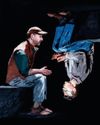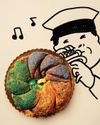
Chop down a poplar tree. Other kinds of wood could work, too, but poplar is an especially soft one, and your task is to trim it into thin planes. These you'll need to coat in a barrier of plaster and animal gluenaked wood is highly absorbent, and you can't have it drinking down everything you put on it. Wait until the barrier has dried. Sand. Repeat until you have a perfectly smooth surface.
Sketch your preferred silhouettes with a stick of charcoal, slather the negative space in a gluey reddish mixture, cover that in translucent gold leaf (glueless, the metal has a queasy green tinge), and burnish that with a wolf's tooth. Now, and only now, you may pick up your brush.
The Met's new show about what happens next, "Siena: The Rise of Painting, 1300-1350," makes clear how astonishing it is that paint, of all things, became the center of Western art. Gold was prettier. Wood was tougher. Textile and ivory, both well represented here, travelled from city to city more freely. Nobody ever looked at an egg yolk, the signature ingredient in tempera, and thought "sublime," let alone "enduring," but here we are, seven centuries later. There may never be another big American exhibition about this freakish little era, when artists figured out how to make colorful ooze do their bidding.
Denne historien er fra October 28, 2024-utgaven av The New Yorker.
Start din 7-dagers gratis prøveperiode på Magzter GOLD for å få tilgang til tusenvis av utvalgte premiumhistorier og 9000+ magasiner og aviser.
Allerede abonnent ? Logg på
Denne historien er fra October 28, 2024-utgaven av The New Yorker.
Start din 7-dagers gratis prøveperiode på Magzter GOLD for å få tilgang til tusenvis av utvalgte premiumhistorier og 9000+ magasiner og aviser.
Allerede abonnent? Logg på

L.A. CONFLAGRATIONAL
The classic mystery that prefigured the latest wildfires.

THE POLITICS OF MORE
Do liberals need to learn how to build?

HOME AGAIN
\"Grangeville\" and \"Curse of the Starving Class.\"

CROWN JEWEL
A golden age for the New Orleans king cake.

DEATH BECOMES HIM
“Mickey 17.”

JOIN MY MATREON!
Family, here's some big news: I have just launched a Matreon account, and I'm inviting you to be a part of this exciting community!

AS HARVARD GOES
Free-speech battles and outside pressures threaten American universities. Will the oldest bend or break?

Ian Frazier on George W. S. Trow's "Eclectic, Reminiscent, Amused, Fickle, Perverse"
George William Swift Trow, Jr.,'s G name fit his quickness of wit and spirit, and his grace.

TRAGEDY AT ROCK SPRINGS
In 1885, white rioters killed dozens of Chinese immigrants. The story of the atrocity is still being unearthed.

DREAMS AND NIGHTMARES
A fan's notes on Super Bowl week.
